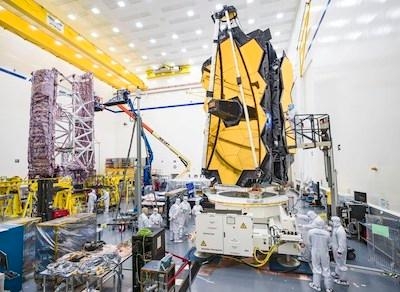Thu, Feb 14, 2019
Tested For Anticipated Acoustic And Sine Vibration Conditions
NASA’s James Webb Space Telescope Spacecraft Element (SCE) successfully completed acoustic and sine vibration testing at Northrop Grumman Corporation in Redondo Beach.

Acoustic and sine vibration testing validates the structural design and verifies the mechanical workmanship and integrity of the actual flight SCE by subjecting it to simulated rigors of the launch environment.
“Mission success remains our focus for Webb, a first of its kind space telescope,” said Scott Willoughby, vice president and program manager, James Webb Space Telescope, Northrop Grumman. “Successful environmental testing of the SCE builds further confidence in its structural design integrity, built to withstand the stresses of launch.”
The SCE was subjected to acoustic noise levels of 140.7 decibels (damage to hearing starts at 85dB while speakers at a concert can be as loud as 120dB or more), which simulated the high noise levels generated from rocket engines and turbulent air flow at high Mach speeds during launch. Vibration testing simulates the vibration and shaking Webb will experience during launch. During testing, the SCE was attached to a large electrodynamic shaker, vibrating it along three orthogonal axes. This back-and-forth or “sinusoidal” vibration was applied by starting at a low, subsonic frequency of 5 hertz (cycles per second) and “sweeping” up to a medium frequency of 100 hertz in the course of just over one minute. Ultimately, the SCE was subjected to protoflight vibration levels required to simulate a rocket launch experience. Testing on the ground assures that Webb can successfully withstand the rigors of its journey to space.
The completion of acoustic and sine vibration testing advances Webb’s SCE to its final environmental test, thermal vacuum testing. Post thermal vacuum testing, Webb will return to Northrop’s clean room for full deployment and integration of the Optical Telescope Element/Integrated Science Instrument Module later this year.
The James Webb Space Telescope will be the world’s premier space science observatory of the next decade. Webb will solve mysteries of our solar system, look to distant worlds around other stars, and probe the mysterious structures and the origins of our universe. Webb is an international program led by NASA with its partners, the European Space Agency and the Canadian Space Agency.
(Image provided with Northrop Grumman news release)
More News
Mid-Continent Instruments and Avionics and True Blue Power ANN's NBAA 2025 Coverage... Visit Them At Booth #3436 101 Aviation Nears STC Approval for Lithium Battery Upgrade on Gulf>[...]
Hertz The standard radio equivalent of frequency in cycles per second of an electromagnetic wave. Kilohertz (kHz) is a frequency of one thousand cycles per second. Megahertz (MHz) >[...]
“NATCA does not endorse, support, or condone any federal employees participating in or endorsing a coordinated activity that negatively affects the capacity of the NAS, or an>[...]
Aero Linx: European Association for Aviation Psychology (EAAP) Since 1956 the European Association for Aviation Psychology (EAAP) provides a forum for professionals working in the >[...]
Aircraft Experienced A Total Loss Of Engine Power During A Go-Around Attempt And Then Impacted A Soybean Field On September 13, 2025, at 1625 eastern daylight time, a Pegasus Quant>[...]
 True Blue Power and Mid-Continent Instruments and Avionics Power NBAA25 Coverage
True Blue Power and Mid-Continent Instruments and Avionics Power NBAA25 Coverage ANN's Daily Aero-Term (10.11.25): Hertz
ANN's Daily Aero-Term (10.11.25): Hertz Aero-News: Quote of the Day (10.11.25)
Aero-News: Quote of the Day (10.11.25) ANN's Daily Aero-Linx (10.11.25)
ANN's Daily Aero-Linx (10.11.25) NTSB Prelim: Pegasus Quantum 15
NTSB Prelim: Pegasus Quantum 15



